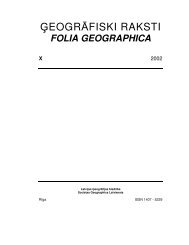eogrÄfiski raksti folia geographica xii - Ä¢eogrÄfijas un Zemes zinÄtņu ...
eogrÄfiski raksti folia geographica xii - Ä¢eogrÄfijas un Zemes zinÄtņu ...
eogrÄfiski raksti folia geographica xii - Ä¢eogrÄfijas un Zemes zinÄtņu ...
You also want an ePaper? Increase the reach of your titles
YUMPU automatically turns print PDFs into web optimized ePapers that Google loves.
67<br />
HUMAN GEOGRAPHY<br />
the desire to go abroad to gain knowledge and experience and then to return to Latvia. To be<br />
sure, it is impossible to know how much time respondents will finally end up spending abroad.<br />
Neither do we have a clear sense of whether someone who has been away for several years will<br />
be able to adapt to new circumstances in Latvia, or whether that person will be able to return to<br />
Latvia at all.<br />
It will take several years before we can know whether various labour force forecasts are<br />
actually valid. In the early 1990s, we must remember, developed co<strong>un</strong>tries believed that there<br />
would be a flood of immigrants from Central and Eastern Europe, but in the event, that did not<br />
happen.<br />
Lots of Latvians work abroad, although the precise numbers are not known – many<br />
people do not declare their income or register as having worked abroad. There has been no<br />
detailed analysis of people who have permits to work abroad. Data of the Eurobarometer survey<br />
indicated that 3 % of Latvia’s respondents have work experience in the EU Member states in the<br />
last two years [Eurobarometer 2002, 44]. Many work at seasonal jobs, and not everyone works<br />
legally. Seasonal farm work is one of the main areas of labour migration. Job offers often<br />
appear in local newspapers, because people in the rural areas and in small towns face a<br />
comparatively higher level of <strong>un</strong>employment than is the case in Latvia’s larger cities. Often one<br />
member of a family goes abroad to do a seasonal job, because the income that can be earned in<br />
a couple of months abroad can meet and even exceed the annual income in Latvia. This ensures<br />
better living conditions, as well as better opport<strong>un</strong>ities for education. Ireland and Great Britain<br />
have been particularly popular destinations. There are already considerable numbers of people<br />
from Latvia in both co<strong>un</strong>tries.<br />
Extensive debates in society were created by two documentary films, “Atrasts Amerikā”<br />
(Fo<strong>un</strong>d in America) and “Sprīdītis Amerikā” (Sprīdītis in America). (Sprīdītis is a character in a<br />
classic book by the early 20 th century author Anna Brigadere. He is a little boy who goes out<br />
into the world to find his fort<strong>un</strong>e and to prove his mettle). Both films focus on people who<br />
moved to the United States in the 1990s. Since there have been no extensive studies about the<br />
way in which these migrants have adapted to life in a new environment, about how they are<br />
doing in life and work, the two films are a useful ancedotal source. They can be analysed in a<br />
broader context, to indicate the multi-faceted aspects of migration – why people decided to<br />
leave, what they are doing, what the situation is in Latvia, and so on.<br />
Disparities of internal migration<br />
There have been important changes in the volume and direction of internal migration in<br />
Latvia. The total volume of internal migration has declined considerably from the maximum at<br />
the beginning of the 1990s. During years 1993-1998 the volume of internal migration has<br />
stabilized at approximately 39,000 people per year, but in 2002 has reduced at approximately<br />
31,000 inhabitants per year (Table 3).<br />
The migration pattern is strongly influenced by urban development. Processes of<br />
urbanisation in Latvia are typified by a specific situation involving the metropolitan area of<br />
Riga. In the 1970s-80s the area saw massive urbanisation due to rapid industrialization and the<br />
fact that the prevailing destination for many migrants (both from rural areas of Latvia and<br />
territories of the rest of Soviet Union), along with the city of Riga, was to regional centres and<br />
suburban settlements of Riga. According Gayer (2002b), following kind development of<br />
suburban satellites is a typical indication of the intermediate stage of differential urbanization.<br />
Riga is the largest and still growing centre of economical activities, thus continuing a<br />
long historical trend. 40% of migration flows involve the city of Riga. Riga’s size and<br />
economical dominance over a wide territory have a strong influence on the development of<br />
settlements, population density, migration, and economically f<strong>un</strong>ctional interactions, both<br />
directly and indirectly. In terms of suburban traffic development, the densely populated areas<br />
stretch out like rays from Riga. Riga – Aizkraukle corridor along the valley of the River<br />
Daugava is especially noticeable. There is a railway line and a highway and there is intensive<br />
economic development along the major traffic highways. A similar pattern can be seen in the<br />
Sigulda – Saulkrasti – Tukums – Jelgava directions. The development of densely populated<br />
zones creates favourable conditions for intensive economic activities of these settlements. There

















